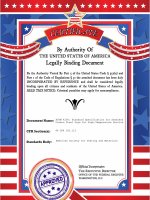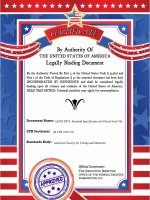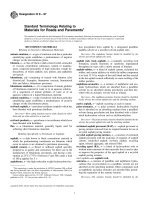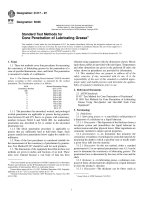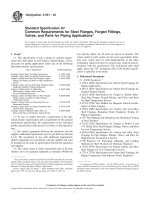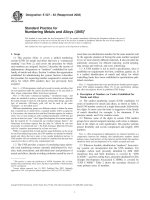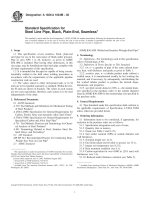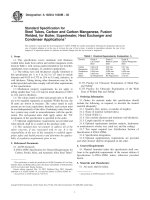Tiêu chuẩn ASTM A 1006 Standard Specification for Steel Line Pipe, Black, Plain End, Laser Beam Welded
Bạn đang xem bản rút gọn của tài liệu. Xem và tải ngay bản đầy đủ của tài liệu tại đây (48.62 KB, 6 trang )
Designation: A 1006/A 1006M – 00
Standard Specification for
Steel Line Pipe, Black, Plain End, Laser Beam Welded1
This standard is issued under the fixed designation A 1006/A 1006M; the number immediately following the designation indicates the
year of original adoption or, in the case of revision, the year of last revision. A number in parentheses indicates the year of last
reapproval. A superscript epsilon (e) indicates an editorial change since the last revision or reapproval.
TABLE 1 Dimensions and Weight [Mass] Per Unit Length
1. Scope
1.1 This specification covers laser beam welded, black,
plain end steel pipe for use in the conveyance of fluids under
pressure. Pipe in sizes NPS 1 to 26, inclusive, with nominal
wall thickness 0.750 in. [19.1 mm] or less, as given in Table 1,
is included. Pipe having other dimensions, in this size range,
may be furnished provided such pipe complies with all other
requirements of this specification.
1.2 It is intended that the pipe be capable of being circumferentially welded in the field when welding procedures in
accordance with the requirements of the applicable pipeline
construction code are used.
1.3 The values stated in either inch-pound units or in SI
units are to be regarded separately as standard. Within the text,
the SI units are shown in brackets. The values in each system
are not exact equivalents: therefore, each system is to be used
independently of the other, without combining values in any
way.
1.4 The following precautionary statement pertains to the
test method portion, Section 14, of this specification. This
standard does not purport to address all of the safety concerns,
if any, associated with its use. It is the responsibility of the user
of this standard to establish appropriate safety and health
practices and determine the applicability of regulatory limitations prior to use.
NOTE 1—Pipe having an outside diameter and/or wall thickness intermediate to those listed in this table are also permitted.
NPS
Designator
1
2. Referenced Documents
2.1 ASTM Standards:
A 370 Test Methods and Definitions for Mechanical Testing
of Steel Products2
A 530/A 530M Specification for General Requirements for
Specialized Carbon and Alloy Steel Pipe2
A 450/A 450M Specification for General Requirements for
Carbon, Ferritic Alloy, and Austenitic Alloy Steel Tubes2
A 751 Test Methods, Practices, and Terminology for
Chemical Analysis of Steel Products3
A 941 Standard Terminology Relating to Steel, Stainless
Steel, Related Alloys, and Ferroalloys2
Outside Diameter
Wall Thickness
in.
mm
in.
mm
0.133
0.358
0.140
0.382
0.145
0.400
0.083
0.436
0.083
0.552
0.083
0.600
0.083
0.318
0.083
0.674
0.083
0.750
0.083
0.750
0.125
0.750
0.156
0.750
0.172
0.750
0.188
0.750
0.188
0.750
0.188
0.750
0.219
0.750
0.219
0.750
0.250
0.750
0.250
0.750
3.4
9.1
3.6
9.7
3.7
10.2
2.1
11.1
2.1
14.0
2.1
15.2
2.1
8.1
2.1
17.1
2.1
19.1
2.1
19.1
3.2
19.1
4.0
19.1
4.4
19.1
4.8
19.1
4.8
19.1
4.8
19.1
5.6
19.1
5.6
19.1
6.4
19.1
6.4
19.1
1.315
33.4
14
1⁄
1.660
42.2
11⁄2
1.900
48.3
2
2.375
60.3
21⁄2
2.875
73.0
3
3.500
88.9
31⁄2
4.000
101.6
4
4.500
114.3
5
5.563
141.3
6
6.625
168.3
8
8.625
219.1
10
10.750
273.1
12
12.750
323.9
14
14.000
355.6
16
16.000
406.7
18
18.000
457
20
20.000
508
22
22.000
559
24
24.000
610
26
26.000
660
Weight [Mass] per Unit
Length
lb/ft
kg/m
1.68
3.66
2.27
5.22
2.72
6.41
2.03
9.04
2.48
13.71
3.03
18.60
3.48
12.52
3.92
27.57
4.86
38.59
5.80
47.10
11.36
63.14
17.67
80.18
23.13
96.21
27.76
106.23
31.78
122.27
35.80
138.30
46.31
154.34
50.99
170.37
63.47
186.41
68.82
202.44
2.52
4.55
3.43
7.77
4.07
9.58
3.01
13.47
3.67
20.37
4.50
27.63
5.15
18.68
5.81
40.99
7.21
57.56
8.61
70.27
17.04
94.20
26.54
119.64
34.67
143.56
41.52
158.49
47.54
182.42
53.53
206.25
69.38
230.27
76.42
254.30
95.26
278.32
103.15
301.87
2.2 API Publication:
API RP 5L3 Recommended Practice for Conducting DropWeight Tear Tests on Line Pipe4
1
This specification is under the jurisdiction of ASTM Committee A01 on Steel,
Stainless Steel and Related Alloys and is the direct responsibility of Subcommittee
A01.09 on Carbon Steel Tubular Products.
Current edition approved Jan. 10, 2000. Published May 2000.
2
Annual Book of ASTM Standards, Vol 01.01.
3
Annual Book of ASTM Standards, Vol 01.02.
4
Available from American Petroleum Institute, 1220 L Street, N.W., Washington, DC 20005-4070.
Copyright © ASTM International, 100 Barr Harbor Drive, PO Box C700, West Conshohocken, PA 19428-2959, United States.
1
A 1006/A 1006M
6.2 The internal and external weld protrusion resulting from
the welding process shall be removed, in accordance with the
requirements of 18.1 and 18.2.
6.3 The weld seam and its heat affected zone shall receive
either a normalizing heat treatment or a continuous in-line heat
treatment in such a manner that no untempered martensite
remains. Complete penetration and coverage of the weld and
the weld heat affected zone by this heat treatment shall be
confirmed by periodic metallographic examination of weld
area cross-section specimens at least once per working shift.
2.3 ASME Standard:
ASME Boiler and Pressure Vessel Code, Section IX, Welding and Brazing Qualifications5
3. Terminology
3.1 Definitions of Terms Specific to This Standard:
3.1.1 laser beam welding, n—a welding process that utilizes
a laser beam to produce melting of full thickness of edges to be
welded, followed by the fusion of those edges.
3.1.2 specified outside diameter, n—the outside diameter
shown in the purchase order or in Table 1 for the applicable
NPS size.
3.2 Definitions—For definitions of other terms used in this
specification, refer to Terminology A 941.
7. Chemical Composition
7.1 The steel shall contain no more than 0.22 % carbon,
0.015 % sulfur, and 0.025 % phosphorus, by heat and product
analyses.
7.2 The steel shall contain no more than 0.0007 % boron, by
heat analysis.
7.3 The carbon equivalent (CE) value for each heat shall not
exceed 0.40 %, calculated using the product analyses and the
following equation:
TABLE 2 Tensile Requirements
Grade
Yield Strength,A
min.
psi
35
50
60
70
80
A
35
50
60
70
80
000
000
000
000
000
MPa
240
345
415
485
550
Yield Strength,A
max.
psi
65
77
80
87
97
000
000
000
000
000
MPa
450
530
550
600
670
Tensile Strength,
min.
psi
60
70
75
80
90
000
000
000
000
000
MPa
415
485
515
550
620
CE 5 C 1 F
F
Mn Si Cu
Ni Cr 1 Mo 1 V 1 Cb
6 1 24 1 15 1 20 1
5
G
(1)
where:
F = a compliance factor that is dependent upon the carbon
content, as shown below:
Yield strength requirements are not applicable for transverse weld tests.
Carbon Content, %
<0.06
0.06
0.07
0.08
0.09
0.10
0.11
0.12
0.13
4. Ordering Information
4.1 Information items to be considered, if appropriate, for
inclusion in the purchase order are as follows:
4.1.1 Specification designation and year of issue,
4.1.2 Quantity (feet or metres),
4.1.3 Grades (see Table 2 or 8.6),
4.1.4 Size, either nominal (NPS) or outside diameter and
wall thickness,
4.1.5 Nominal length (see 16.3),
4.1.6 End finish (plain end beveled or special, see 17.1),
4.1.7 Bar coding (see 20.3),
4.1.8 Special requirements, and
4.1.9 Supplementary requirements.
F
0.53
0.54
0.56
0.58
0.62
0.66
0.70
0.75
0.80
Carbon Content, %
0.14
0.15
0.16
0.17
0.18
0.19
0.20
0.21
0.22
F
0.85
0.88
0.92
0.94
0.96
0.97
0.98
0.99
1.00
7.4 A heat analysis shall be made for each heat of steel
furnished under this specification.
7.5 Product analyses shall be made on at least two samples
from each heat of steel.
7.6 All analyses shall be in accordance with Test Methods,
Practices, and Terminology A 751, and shall include all elements required in the carbon equivalent equation of 7.3, in
addition to titanium, phosphorus, sulfur, and boron, except that
the product analysis for boron is not required. Titanium is
reported for information only and is not a cause for rejection.
7.7 If one or both of the product analyses representing a heat
fails to conform to the specified requirements, the heat shall be
rejected, or two additional analyses shall be made on the
sample that failed, each of which shall conform to the specified
requirements.
5. General Requirements
5.1 Pipe furnished under this specification shall conform to
the applicable requirements of Specification A 530/A 530M
unless otherwise provided herein.
6. Materials and Manufacture
6.1 Pipe shall be welded from one side by the laser beam
welding process using a single pass with an appropriate
shielding gas. The pipe shall have one longitudinal seam. The
weld shall be made in accordance with a qualified welding
procedure as specified in ASME Boiler and Pressure Vessel
Code, Section IX, Paragraph QW-264. The edges may be
preheated.
8. Tensile Property Requirements
8.1 The material shall conform to the requirements for
tensile properties given in Table 2 and in 8.6. The yield strength
maxima apply only to pipe NPS 8 and larger.
8.2 The yield strength corresponding to a total extension
under load of 0.5 % of the gage length shall be determined.
8.3 A test specimen taken across the weld shall show a
tensile strength not less than the minimum tensile strength
specified for the grade of pipe required. Test specimens shall
5
Available from ASME International, Three Park Avenue, New York, NY
10016-5990.
2
A 1006/A 1006M
test specimens as required when the absorbed energy is
expected to exceed 80 % of the full scale capacity of the testing
machine.
9.3 The minimum average absorbed energy of pipe body for
any Charpy V-notch test shall be calculated from the equation
given below for pipe NPS 5 through NPS 26. Values calculated
by this equation as less than 30 ft-lbf [40 J] shall be taken as
30 ft-lbf [40 J] minimum average.
exhibit at least 10 % elongation in 2 in. [50 mm]. This test is
not required for pipe under NPS 8.
8.4 Transverse tension tests shall be performed on NPS 8
and larger and the specimens shall be taken opposite the weld.
All transverse test specimens shall be approximately 11⁄2 in.
[38 mm] wide in the gage length and shall represent the full
wall thickness of the pipe from which the specimen was cut.
8.5 For pipe smaller than NPS 8, longitudinal tests shall be
performed. Such tests shall be either strip specimens taken
approximately 90° from the weld or full section specimens, at
the option of the manufacturer.
8.6 Grades intermediate to those shown in Table 2 may be
furnished. For such grades, the permissible yield strength range
shall be as given in Table 2 for the next higher grade, and the
required minimum tensile strength shall exceed the required
minimum yield strength by the same amount as is given in
Table 2 for the next higher grade.
8.7 The minimum elongation in 2 in. [50 mm] for all grades
shall be determined by the following equation:
CV ~fullsize! 5 C 3 =D 3 S1.5
where:
CV =
C =
D =
S
=
minimum average value required, ft-lbf [J],
0.024 [0.000 354],
specified outside diameter, in. [mm], and
0.72 3 specified minimum yield strength, ksi [MPa].
NOTE 1—Charpy testing is not required on any pipe smaller than NPS
5 or for pipe NPS 5 or larger with insufficient specified wall thickness to
permit at least 1⁄2 size specimens to be obtained.
9.4 When subsize specimens are used, the minimum average absorbed energy shall be that specified for full size
specimens multiplied by 0.67 (for 2⁄3 size specimens) or 0.50
(for 1⁄2 size specimens), rounded to the nearest whole number.
9.5 Testing shall be conducted at a test temperature of 32°F
[0°C], or lower.
9.6 For pipe body tests, each Charpy specimen shall exhibit
at least 75 % shear area.
0.2
A
e 5 C 0.9
U
(3)
(2)
where:
e = minimum elongation in 2 in. [50 mm], percent,
rounded to the nearest percent,
C = 625 000 [1940],
A = the lesser of 0.75 in2 [485 mm2] and the crosssectional area of the tensile test specimen, based on
the specified outside diameter or the nominal specimen width and the specified wall thickness, rounded
to the nearest 0.01 in2 [1 mm2], and
U = specified minimum tensile strength, psi [MPa].
10. Weld Ductility Test
10.1 Flattening Test—The flattening test shall be conducted
by tests on full section specimens of 2 in. [50 mm] minimum
length. The specimens shall be flattened cold between parallel
plates. The weld shall be placed at 90° and at 0° from the
direction of applied force. No crack or breaks exceeding 1⁄8 in.
[3 mm] in any direction in the weld or in the parent metal shall
occur on the outside surface until the distance between the
plates is less than the value of H in the following equation,
except that cracks that occur at the edges of the specimen and
are less than 1⁄4 in. [6 mm] long shall not be cause for rejection:
9. Charpy V-Notch Test
9.1 Pipe body test specimens shall be taken approximately
90° from the weld.
9.2 The Charpy test specimens used shall be those given in
Table 3, except that it shall be permissible to use 2⁄3 or 1⁄2 size
TABLE 3 Relationship Between Pipe Dimensions and Required Charpy Specimens
NOTE 1—Charpy testing is not required on any pipe smaller than NPS 5 or for pipe NPS 5 or larger with insufficient specified wall thickness to permit
at least 1⁄2 size specimens to be obtained.
Specified Wall Thickness, in. [mm]
Specified OD
in. [mm]
59⁄16
[141.3]
65⁄8
[168.3]
85⁄8
[219.1]
103⁄4
[273.1]
123⁄4
[323.9]
14
[355.6]
$16
[$406.4]
Full Size
Transverse
⁄ Size
Transverse
0.469 and thicker
[11.9 and thicker]
0.460 and thicker
[11.7 and thicker]
0.450 and thicker
[11.4 and thicker]
0.443 and thicker
[11.3 and thicker]
0.438 and thicker
[11.1 and thicker]
0.436 and thicker
[11.1 and thicker]
0.434 and thicker
[11.0 and thicker]
0.371 to 0.468
[9.4 to 11.8]
0.334 to 0.459
[8.5 to 11.6]
0.318 to 0.449
[8.1 to 11.3]
0.311 to 0.442
[7.9 to 11.2]
0.307 to 0.437
[7.8 to 11.0]
0.305 to 0.435
[7.7 to 11.0]
0.304 to 0.433
[7.7 to 10.9]
1⁄2 Size
Transverse
23
0.338
[8.8
0.301
[7.6
0.267
[6.5
0.246
[6.2
0.241
[6.1
0.238
[6.1
0.237
[6.0
3
to
to
to
to
to
to
to
to
to
to
to
to
to
to
0.370
9.3]
0.333
8.4]
0.317
8.0]
0.310
7.8]
0.306
7.7]
0.304
7.6]
0.303
7.6]
2⁄3 Size
Longitudinal
1⁄2 Size
Longitudinal
0.310 to 0.337
[7.9 to 9.2]
0.245 to 0.309
[6.2 to 7.8]
0.244 to 0.300
[6.2 to 7.5]
0.242 to 0.256
[6.1 to 6.4]
0.241 to 0.245
[6.1]
...
...
...
...
...
...
...
...
...
A 1006/A 1006M
H5
3.05 t
~0.05 1 3 t/D!
11.4 When computed test pressures are not an exact multiple of 10 psi [100 kPa], they shall be rounded to the nearest
10 psi [100 kPa].
11.5 The minimum hydrostatic test pressure required to
satisfy these requirements need not exceed 3000 psi [20 700
kPa]; however this does not prohibit testing at a higher pressure
at the manufacturer’s option. The hydrostatic test pressure shall
be maintained for not less than 5 s for all sizes.
(4)
where:
H = distance between flattening plates, in. [mm],
t = specified wall thickness, in. [mm], and
D = specified outside diameter, in [mm].
10.2 Guided Bend Test—Root and face guided bend tests
shall be conducted in accordance with Test Methods and
Definitions A 370. The specimens shall not fracture completely
and shall not reveal any cracks or ruptures in the fusion line
longer than 1⁄8 in. [3 mm], except that cracks that occur at the
edges of the specimen and are less than 1⁄4 in. [6 mm] long shall
not be cause for rejection.
12. Nondestructive Examination
12.1 General—The weld seam of each length of pipe shall
be subjected to ultrasonic inspection in accordance with 12.2.
12.2 Ultrasonic Inspection:
12.2.1 Any equipment utilizing the ultrasonic principles and
capable of continuous and uninterrupted inspection of the weld
seam shall be used. The equipment shall be checked with an
applicable reference standard as described in 12.2.2 at least
once every working turn with no more than 8 h between such
checks to demonstrate the effectiveness of the inspection
procedures. The equipment shall be adjusted to produce
well-defined indications when the reference standard is
scanned by the inspection unit in a manner simulating the
inspection of the product. The location of the equipment for
final inspection shall be after hydrostatic test.
12.2.2 Reference Standards—Reference standards shall
have the same diameter and thickness as the product being
inspected, and may be of any convenient length as determined
by the pipe manufacturer. Reference standards shall be either
full sections or coupons taken from the pipe. Reference
standards shall contain one machined notch on the inside
surface and one machined notch on the outside surface or a
drilled hole, with the following dimensions:
11. Hydrostatic Test
11.1 Each length of pipe shall be subjected to the hydrostatic test without leakage through the wall.
11.2 Except as allowed by 11.5, each length of pipe NPS 2
or larger shall be tested, by the manufacturer, to a minimum
hydrostatic pressure determined using the following relationship:
inch pound units:
St
P 5 2D 3 C
(5)
St
P 5 2000D 3 C
(6)
SI units:
where:
P = minimum hydrostatic test pressure, psi [kPa],
S = specified minimum yield strength, psi [MPa],
t = specified wall thickness, in. [mm],
D = specified outside diameter, in. [mm],
C = 0.60 for pipe NPS 2 through NPS 5,
= 0.75 for pipe larger than NPS 5 through NPS 8,
= 0.85 for pipe larger than NPS 8 through NPS 18, and
= 0.90 for pipe larger than NPS 18.
11.3 For pipe sizes smaller than NPS 2, the test pressures
given in Table 4 are arbitrary. For intermediate diameters
smaller than NPS 2, the test pressures given for the next
smaller diameter shall be used.
Parallel Sided Notch
Depth: 5 %t 6 15 %
with min. depth of
0.012 6 0.002 in.
[0.3 6 0.05 mm]
Width: 0.04 in. [1 mm] max.
Length: 2 in. [50 mm] min. at full
depth
NOTE 2—The reference standards defined in 12.2.2 contain simulated
flaws for calibration of nondestructive testing equipment. The dimensions
of these flaws should not be construed as the minimum size imperfection
detectable by such equipment.
12.2.3 Surface condition, operator qualification, extent of
examination, and standardization procedure shall be in accordance with the provisions of Specification A 450/A 450M.
12.2.4 Acceptance Limits—Table 5 gives the height of
acceptance limit signals in percent of the height of signals
produced by the reference flaws. Imperfections in the weld
seam that produce a signal greater than the acceptance limit
given in Table 5 shall be considered defects.
TABLE 4 Hydrostatic Test Pressure
NPS
Designer
Specified
Outside
Diameter
in. [mm]
1
1.315 [33.4]
11⁄4
1.660 [42.2]
11⁄2
1.900 [48.3]
Specified
Wall
Thickness
in. [mm]
0.133
0.179
0.250
03.58
0.140
0.191
0.250
0.382
0.145
0.200
0.281
0.400
[3.4]
[4.6]
[6.4]
[9.1]
[3.6]
[4.9]
[6.4]
[9.7]
[3.7]
[5.1]
[7.1]
[10.2]
Test
Pressure,
Minimum
psi [kPa]
700
850
950
1000
1300
1900
2000
2300
1300
1900
2000
2300
Drilled Hole
⁄ in. [1.6 mm]
dia.
1 16
[4800]
[5900]
[6600]
[6900]
[9000]
[13 100]
[13 800]
[15 900]
[9000]
[13 100]
[13 800]
[15 900]
TABLE 5 Acceptance Limits
Type of Notch
Parallel Sided Notch
Drilled Hole
4
Acceptance Limit
Signal %
100
100
A 1006/A 1006M
theoretical weight [mass]. The weight [mass] of any order item
shall not be more than 1.75 % under its theoretical weight
[mass].
16.2 Wall Thickness—The minimum wall thickness at any
point shall not be more than 8 % under the specified wall
thickness.
16.3 Length—Unless otherwise agreed upon between the
purchaser and the manufacturer, pipe shall be furnished in the
nominal lengths and within the permissible variation in Table
7, as specified.
16.4 Diameter—Pipe sizes NPS 20 and smaller shall permit
the passage over the ends, for a distance of 4 in. [100 mm], of
a ring gage that has a bore diameter no larger than the specified
outside diameter plus the diameter plus tolerance. Diameter
measurements of pipe larger than NPS 20 shall be made with
a diameter tape. Diameter measurements (away from the ends)
of pipe NPS 20 and smaller shall be made with a snap gage,
caliper, or other device that measures actual diameter in a
single plane.
12.3 Disposition of Pipe Containing Defects—Pipe containing defects shall be given one or more of the following
dispositions:
12.3.1 The pipe length shall be rejected.
12.3.2 The portion of the pipe containing the defect shall be
cut off.
12.3.3 The defect shall be removed by grinding, provided
that the remaining wall thickness is within specified limits.
12.3.4 The defect shall be repaired by welding.
13. Number of Tests
13.1 Tensile testing of the pipe body and weld shall be at a
frequency of one test per lot. Each lot, as given in Table 6, shall
consist of each combination of specified outside diameter,
specified wall thickness, and heat.
13.2 A flattening test as described in 10.1 shall be conducted
on test specimens from each end of each coil length for each
pipe size NPS 2 and larger. In the event of a weld stop, the test
shall be performed on each pipe end adjacent to the weld stop.
13.3 For pipe NPS 10 and larger, a guided bend test shall
also be performed in accordance with 10.2, at a frequency of
one test per lot of 50 lengths or less of each combination of
specified outside diameter, specified wall thickness, and grade.
13.4 Charpy V-notch testing of the pipe body shall be as
given in Table 6 for each combination of specified outside
diameter, specified wall thickness, and heat.
17. End Finish
17.1 Pipe furnished to this specification shall be plain-end
beveled with ends beveled to an angle of 30°, +5°, −0°,
measured from a line drawn perpendicular to the axis of the
pipe, and with a root face of 1⁄16 in. [1.6 mm] 6 1⁄32 in. [0.8
mm], or with the special plain-end configurations specified in
the purchase order.
14. Test Methods
14.1 The mechanical properties testing required by this
specification shall conform to those described in Test Methods
and Definitions A 370.
18. Workmanship, Finish and Appearance
18.1 The depth of groove resulting from the removal of the
internal weld protrusion shall not be greater than that given in
Table 8 for the applicable wall thickness. Depth of groove is
defined as the difference between the wall thickness measured
approximately 1 in. [25 mm] from the weld line and the
remaining wall under the groove.
18.2 The external weld protrusion shall not extend above
the surface of the pipe by more than 0.010 in. [0.25 mm].
18.3 Surface imperfections that penetrate more than 8 % of
the specified wall thickness or encroach on the minimum wall
thickness shall be considered defects. Pipe with surface defects
shall be given one of the following dispositions:
18.3.1 The defect shall be removed by grinding, provided
that a smooth curved surface remains and the remaining wall
thickness is within specified limits.
18.3.2 The section of the pipe containing the defect shall be
cut off within the requirements for length.
18.3.3 The length shall be rejected.
18.4 Wall thickness measurements shall be made with a
mechanical caliper or with a properly calibrated nondestructive
15. Dimensions And Weight [Mass] Per Unit Length
15.1 The dimensions and weight [mass] per unit length shall
be as given in Table 1. The weight [mass] per unit length of
pipe having an intermediate outside diameter and/or wall
thickness shall be determined using the following equation:
inch-pound units:
W 5 10.69~D2t!t
(7)
W 5 0.02466~D2t!t
(8)
SI units:
where:
W = weight [mass] per unit length, lb/ft [kg/m]
D = specified outside diameter, in. [mm], and
t = specified wall thickness, in. [mm].
16. Permissible Variation in Weight [Mass] and
Dimensions
16.1 Weight [Mass]—The weight [mass] of a single length
of pipe shall not vary more than +10 %, -3.5 % from its
TABLE 7 Permissible Variations on Lengths
Nominal Length
TABLE 6 Lot Size and Sample Size For Mechanical Testing
Size Designation
Lot Size
Sample Size
< NPS 2
NPS 2 through NPS 5
NPS 6 through NPS 12
> NPS 12
50 tons or fraction thereof
400 lengths
200 lengths
100 lengths
1
1
1
1
5
ft
m
Minimum Length Minimum Avg. Length Maximum Length
For Each Order Item
ft
m
ft
m
ft
m
20
40
50
60
80
6
12
13
18
24
9.0
14.0
17.5
21.0
28.0
2.74
4.27
5.33
6.40
8.53
17.5
35.0
43.8
52.5
70.0
5.33
10.67
13.35
16.0
21.34
22.5
45.0
55.0
65.0
85.0
6.86
13.72
16.76
19.81
25.91
A 1006/A 1006M
TABLE 8 Depth of Groove Tolerance
Specified Wall Thickness (t),
in. [mm]
Maximum Depth of Groove,
in. [mm]
0.150 [3.8] or less
>0.150 [3.8] to
< 0.300 [7.5]
0.300 [7.5] or greater
0.10t
0.015 [0.4]
dent and a prolongation of the original contour of the pipe.
Cold formed dents deeper than 1⁄8 in. [3.2 mm] shall be free of
sharp-bottom gouges. The gouges may be removed by grinding, provided that the remaining wall thickness is within
specified limits. The length of the dent in any direction shall
not exceed one half the pipe diameter.
0.05t
19. Certification
19.1 A certified test report shall be furnished.
testing device of appropriate accuracy. In case of a dispute, the
measurement determined by the use of a mechanical caliper
shall govern.
18.5 Repairs of the pipe body, by welding, are not permitted.
18.6 Repair of the Weld—Defects in welds may be repaired
only by agreement between the purchaser and the manufacturer; such repairs shall be in accordance with Specification
A 530/A 530M, except that the repair depth shall not exceed
70 % of the specified wall thickness of the pipe and back-toback repairs are not permitted. No repair of repair weld is
permitted.
18.7 Pipe smaller than NPS 4 shall be reasonably straight.
For all other pipe, the measured deviation from a straight line
shall not exceed 0.2 % of the length.
18.8 The pipe shall contain no dents greater than 10 % of
the specified outside diameter or 1⁄4 in. [6.4 mm], whichever is
smaller, measured as the gap between the lowest point of the
20. Package Marking
20.1 Each length of pipe shall be legibly marked by stenciling to show: specification number, the name or brand of the
manufacturer, LBW, the grade, wall thickness, diameter, heat
number, and the length, except as allowed in 20.2. The length
shall be marked in feet and tenths of a foot, or metres to two
decimal places, as applicable.
20.2 For pipe NPS 11⁄2 and smaller that is bundled, the
information in 20.1 may be marked on a tag that is securely
fastened to each bundle.
20.3 In addition to the requirements of 20.1 and 20.2, bar
coding is acceptable as a supplementary identification method.
The purchaser may specify in the order a specific bar coding
system to be used.
21. Keywords
21.1 black steel pipe; laser beam welded; line pipe
SUPPLEMENTARY REQUIREMENTS
The following supplementary requirement shall apply only when specified in the purchase order.
S1.2 The temperature selected for conducting the dropweight tear test, the test frequency, and the criteria for
acceptance shall be as specified in the purchase order.
S1. Drop-Weight Tear Testing
S1.1 The drop-weight tear test shall be conducted in accordance with API RP 5L3.
The American Society for Testing and Materials takes no position respecting the validity of any patent rights asserted in connection
with any item mentioned in this standard. Users of this standard are expressly advised that determination of the validity of any such
patent rights, and the risk of infringement of such rights, are entirely their own responsibility.
This standard is subject to revision at any time by the responsible technical committee and must be reviewed every five years and
if not revised, either reapproved or withdrawn. Your comments are invited either for revision of this standard or for additional standards
and should be addressed to ASTM Headquarters. Your comments will receive careful consideration at a meeting of the responsible
technical committee, which you may attend. If you feel that your comments have not received a fair hearing you should make your
views known to the ASTM Committee on Standards, at the address shown below.
This standard is copyrighted by ASTM, 100 Barr Harbor Drive, PO Box C700, West Conshohocken, PA 19428-2959, United States.
Individual reprints (single or multiple copies) of this standard may be obtained by contacting ASTM at the above address or at
610-832-9585 (phone), 610-832-9555 (fax), or (e-mail); or through the ASTM website (www.astm.org).
6
